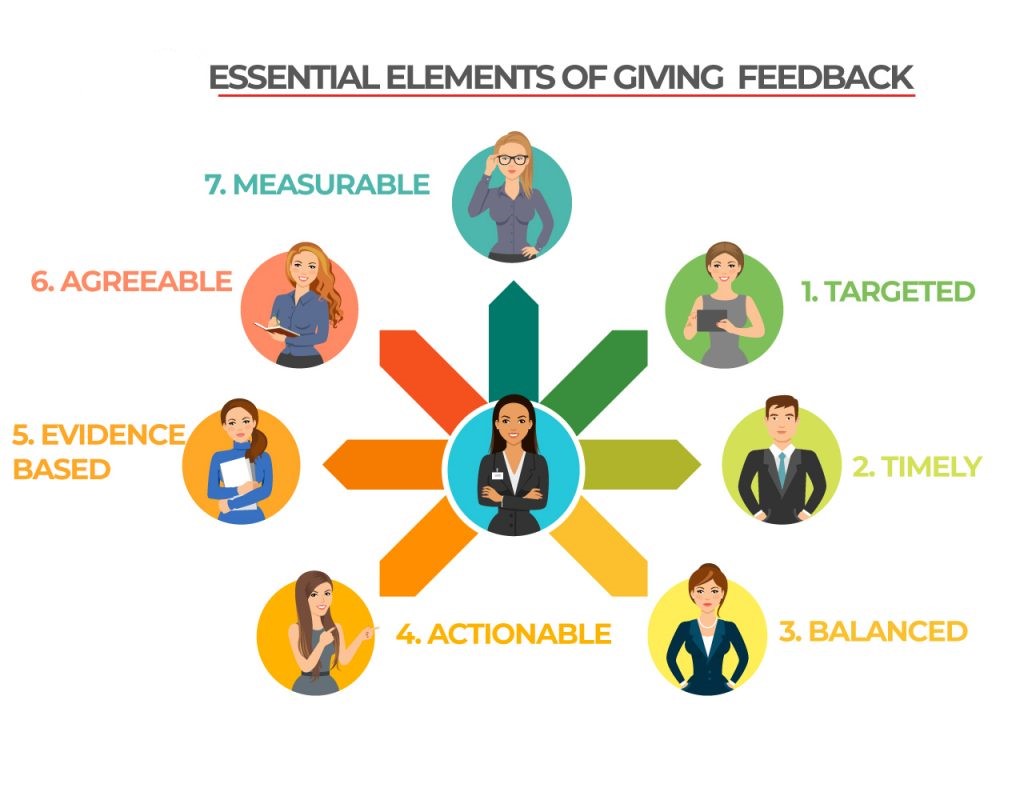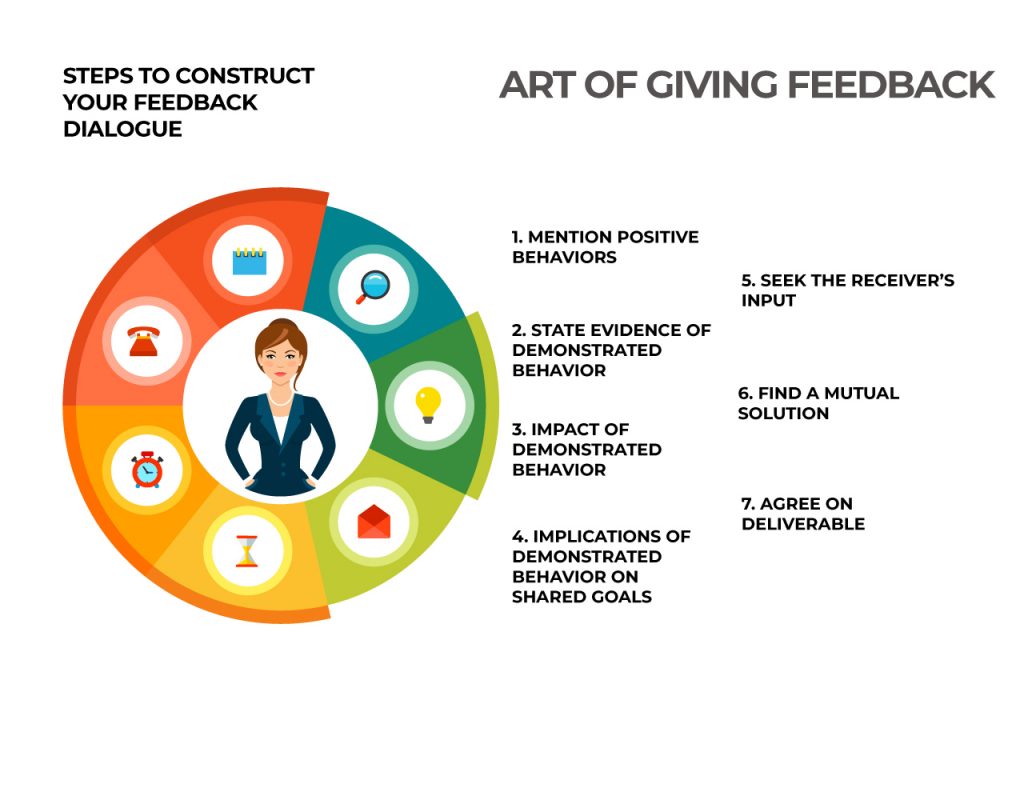What is Feedback? How to Give Feedback to Others Effectively
Organizations are run by the collective efforts of many people within and outside the organization. Even in your daily life, there are many individuals involved who make your life journey wholesome. In every aspect of the organization or your own life where there are people involved who contribute in any way, you can’t avoid providing feedback to ensure things are aligned and as per your expectations and shared goals. How to give feedback that is effective and leads to results is what will be covered in this post.
We often give feedback to multiple people on so many occasions, without even realizing that giving feedback is a skill that many successful leaders have been striving to master. We call it the ‘Art of Giving feedback’. Whether it is in the context of a leader or an individual in personal life, the ability to give an effective feedback is a powerful and important factor in personal or professional success.
The ability to give constructive and more importantly effective feedback is a skill and a very important one. Moreover, the ability to give feedback is considered one of the critical leadership competencies for many organizations. But why do we need to give feedback to people? The answer is simple, to align the behavior of the person to match your goals and expectations.
Whether in personal or professional life, if things are not going on course, the corrective measures start from giving feedback to individuals involved. It doesn’t mean you can give feedback to anyone, anytime and anywhere. Your ability to give feedback that works and how to give an effective feedback is a key to success and this is what we will cover in this post.
Contents
What is feedback?
It is very important to understand what do we mean by feedback as it often confused with other forms of communication or dialogues.
Feedback is a process of dialogue with an individual or group of individual with an intention to change specific behavior to achieve desired results. Obviously, you want to change behavior because this past behavior is not conducive to the results that you want to achieve.
It is important to note the difference between criticism, advice, suggestion, and feedback. Criticism is not targeted to change behavior but focuses on action, personality or trait. Suggestion and advice do not include shared goals.
The Challenges while Giving Feedback
The inherent challenges with feedback are very easy to understand. We simply don’t like feedback. Yes, no matter how much you debate about it, the fact is that people don’t like feedback.
There are two reasons for that, first is that people see feedback as a directive to correct something that they are doing wrong, and people don’t want to be told that they are wrong.
Second, feedback encourages change in behavior and we humans are inherently averse to change.
So why am I telling you this? Because I want you to know that for your feedback to be effective, it is very important that you are well aware of these two challenges and mitigate them to the best of your abilities. This defines your skill in ‘Art of Giving Feedback’.
When, who and why to give feedback?

It is very important to address these three questions. As far as when is concerned, you should always try to give feedback to an individual as soon as possible. Whenever you need to give feedback about a specific behavior it has to come as early as possible when that behavior is demonstrated.
For example, if an employee has been rude with the customer, you should give feedback as soon as that rude behavior is demonstrated. The longer you delay the more difficult it’ll be for the employee to constructively receive the feedback.
It doesn’t at all mean that it has to be instant. You must wait for an appropriate time and place to give your feedback. If you start giving feedback to your employee when he is addressing another customer on his working desk it may not work very well.
Who to give feedback, is equally important. You give feedback to individual when giving feedback is aimed at achieving a shared objective. Unsolicited feedback to someone who does not share a mutual goal is counterproductive. You must ask yourself if the demonstrated behavior by the individual has an impact on your performance in achieving an objective.
Also, is the person in question committed to your objective whether voluntarily, by profession or mutual agreement. For example, you can give feedback to your subordinate or even supervisor on shared goals within an organization as they are committed to your objective by their profession.
However, you shouldn’t simply give feedback to a friend of your colleague who may be working in the same profession but not sought feedback from you. It is very difficult for unsolicited feedback without the commitment from the individual receiving the feedback to work.
About why to give feedback is also important. If the person receiving the feedback is committed to the shared objective it is important that you give the individual your perspective on why it is important to change a specific behavior for both of you to succeed. The truth is you always need other’s perspective to improve, no individual can assess all their demonstrated behaviors objectively.
 |
| An essential element of every feedback is to drive change in behavior. Not to be confused by feedback given by customers for a product or service.
The process of giving feedback here involves individual feedback. The ability to give feedback is an essential skill for leaders and managers. Also, providing feedback to individuals is an essential skill for coaches. The Coaching and Feeback skills are often a complementary and essential part of every leadership competency framework. |
How to give feedback?
The following model of feedback provides you a framework to the art of giving feedback that is effective and helps you achieve your objective. These are the essential elements of giving feedback.

1. Targeted
The feedback must be specifically targeted to the demonstrated behavior and not personalities, actions, traits or opinions. It is a very important aspect that a skilled manager or leader is quite well aware of. In the earlier example of an employee being rude to your customers, the feedback should not talk about the individual being rude to the customer.
This is essentially to avoid being judgemental and typecasting the employee as having a trait of being rude to the customer. You giving feedback must focus on the specific behavior that the employee demonstrated like interrupting the customer many times and harsh tone used by your employee.
However, your conclusion may state that by demonstrating such behavior you have been or may be perceived as being rude to the customer.
2. Timely
As discussed earlier and can’t be emphasized more that you should give feedback as early as possible when the demonstrated behavior occurs.
You can’t simply give feedback to your employee three months after the even when he or she had been rude with your customers. Apart from further damage that the repetition of the demonstrated behavior can do, it will also not be accepted as a feedback by the employee and there is a high probability that the individual may think that he or she is being unfairly targeted for an event that occurred in past.
Ask any married couple the major contention of their argument and they will tell you that bringing past demonstrated behavior to their discussion the one.
3. Balanced
It is easy to jump to the demonstrated behavior you want to correct but the best practice is to talk about the positive behavior that the person may be demonstrating which is working well for your shared goals.
For example, your employee who has been rude with the customer may be punctual and hard working. If you talk about the positive behaviors first and then move on to the demonstrated behavior that needs to be changed, you are increasing the chances of success of feedback giving exercise greatly.
The person in question who is receiving the feedback will be more receptive to your feedback and will not feel targeted. This will condition his or her mind to accept what is good and also something that he or she may not be doing that well.
4. Actionable
It is important and has been mentioned many times that feedback is always aimed at changing specific behavior and not personalities or traits. Anything that does not address changing behavior is not feedback, it can be a suggestion, recommendation, advice, and even critique.
Therefore, the behavior that needs to be changed should be clear and actionable. For example, you give feedback to an individual to be more customer-centric, while it may be a behavior but the other individual does not know what actions does he or she take to be customer-centric.
Helping the individual with actions on specific behaviors will make the giving feedback exercise successful, like greeting a customer, showing empathy by relating to their problem, or asking questions to find the root of the problem could be some of the examples of actionable behavior.
While these eventually lead to the broader customer-centric behavior, but you need to mention actionable behaviors in your feedback to make if effective.
5. Evidence-based
It is very important that while giving feedback, evidence of the demonstrated behavior must be given. This essentially increases your chance of constructive acceptance of the feedback and correction into desired behavior targeted through feedback.
In the example of the rude employee a customer satisfaction survey score, customer feedback or even your observation on specific behavior are evidence. However, minimize subjective human observation and maximize fact-based evidence. In the example, a customer satisfaction survey is far more powerful evidence than other people’s observation.
6. Agreeable
You have to ensure that the feedback is agreeable to the employee. When you give the feedback and employee has specific reasons about the demonstrated behavior, you must provide clarification or remedy for the specific agreement for the feedback process to succeed.
For example, you are giving an employee feedback on coming late to the office on a regular office and the employee insists that as he does not have a parking space allotted to him, even after reaching office on time he is not on the desk due to delay in finding the parking.
You either ensure that his reserved parking is allotted to him at the earliest or you will make it clear to him that as per the company policies you are not eligible for the parking and you should look for an alternate arrangement or reach even earlier to ensure that you attend your desk on time.
If you provide feedback without making it agreeable, you reduce the chances of reaching the desired objective through feedback. However, don’t get involved in too many reasons, as that often has more to do about excuses. In this scenario make the commitment factor behind the shared objective, in this case, the employee, employer agreement and company policy to rest your case.
7. Measurable
When you’re able to make your feedback agreeable it is important to have the correction in the demonstrated behavior measurable. Essentially if you can’t measure the efficacy of your feedback you can’t improve it.
In the example that we are following a way to measure whether your employee is dealing with your customers in a positive and principled way could be an improvement in the customer satisfaction survey.
Moreover, you must have a timeline and a magnitude of improvement to measure the improvement based on your feedback. It can be for example an improvement in customer satisfaction survey by 1 point on a scale of 5 within 4 weeks.
Steps to construct your feedback dialogue
It is important to construct your feedback dialogue to ensure that you are able to give effective feedback and also, that you achieve the desired objective by changing the behavior of the individual you are giving feedback to. There are seven key components of a feedback dialogue.

An effective session of giving feedback follows these steps in order:
1. Mention positive behaviors
Every individual does a few things right and demonstrates those behaviors. A conversation that starts by mentioning those positive behaviors first greatly increases the acceptance of the feedback. it’s important to ensure that these are evidence-based positive behaviors and not mere adulations for the sake of phrasing your feedback dialogue.
For example, if a member of your project team is not paying attention to details in the project for which you need to give feedback on, begin by mentioning that you had initially shown great interest in the project and shown great performance in the earlier project.
What if you can’t find any positive behaviors to mention? It is highly unlikely but it’s better to not make up a positive behavior than to give one. In this rare scenario, you may begin by stating anything positive about the individual that you actually believe actually is. However, in the context of feedback don’t forget that it is about behavior, not personality.
2. State evidence of demonstrated behavior
The positive behavior should be followed by the evidence of the demonstrated behavior that needs to change. For encouraging an entirely new behavior to be demonstrated you can provide an example of that behavior demonstrated by someone else.
In the example of your rude customer service employee, if you wish to inculcate empathy in conversation, give an example of some other employee that is already doing it. For his rude behavior with the customer which is an already demonstrated behavior, give the example of low customer satisfaction score.
3. State impact of the demonstrated behavior
State the immediate impact of the demonstrated behavior that is often negative. For example you customer service employee should be made aware of the customer satisfaction score going down and the customer by word of mouth has will give a negative image of the organization.
This is nothing but long term implications of the demonstrated behavior on your shared goal. Disgruntled customer, for example, being followed will lead to loss of revenue, rand image and reputation of the organization.
5. Seek the receiver’s input
The other side has a story as well, any effective feedback should also focus on taking inputs for the individual receiving the feedback. The caveat is that you need to churn out the excuses and focus on genuine inputs.
Feedback is not a directive or order, the whole purpose of the feedback process is to also get the other side of the story and finding an agreement.
6. Find a mutual solution
Once the feedback receiver has presented the other side of the story, by providing the impact of the demonstrated behavior on the short term and long term results you will seek an agreement on that.
Next will be seeking an agreement after eliminating any hurdles in demonstrating the expected behavior.
7. Agree on actionable
It is now time to agree on actionable. As mentioned earlier the actionable must be measurable and bound by time.

